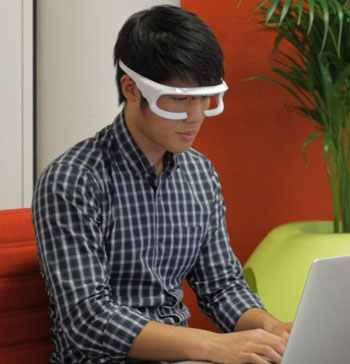| Nov 27, 2012 |
New, wearable device resets body clock
|
|
(Nanowerk News) Last week saw the launch of Re-Timer, a wearable green light device invented by Flinders University sleep researchers to reset the body’s internal clock.
|
|
The portable device, which is worn like a pair of sunglasses and emits a soft green light onto the eyes, will help to counter jet lag, keep shift workers more alert and get teenagers out of bed by advancing or delaying sleeping patterns.
|
|
Psychologist Professor Leon Lack, the device’s chief inventor, said that the light from Re-Timer stimulates the part of the brain responsible for regulating the 24-hour body clock.
|
 |
| Re-Timer
|
|
The device has been designed with the benefit of 25 years of sleep research at Flinders University.
|
|
“Body clocks or circadian rhythms influence the timing of all our sleeping and waking patterns, alertness, performance levels and metabolism,” Professor Lack said.
|
|
“Photoreceptors in our eyes detect sunlight, signal our brain to be awake and alert, and set our rhythms accordingly. These rhythms vary regularly over a 24-hour cycle. However, this process is often impaired by staying indoors, traveling to other times zones, working irregular hours, or a lack of sunlight during winter months.
|
|
“Our extensive research studies have shown that green light is one of the most effective wavelengths for advancing or delaying the body clock, and to date is the only wearable device using green light.”
|
|
Professor Lack recommended wearing the glasses for three days for 50 minutes each day either after awakening in the morning to advance the body clock, or before bed for those wanting to delay the body clock to wake up later.
|
|
He said that Re-Timer’s light therapy offers a safer and, in many cases, more effective treatment for mistimed sleep than drug alternatives.
|
|
The device is being produced by local manufacturing firm SMR Components.
|
|
South Australia’s Minister for Manufacturing, Innovation and Trade Mr Tom Koutsantonis said Re-Timer is an outstanding example of the type of home-grown innovative product the State Government is aiming to encourage through its Manufacturing Strategy.
|
|
“This successful collaboration is evidence of what can be done when our manufacturing companies link with major research institutions for commercial outcomes.”
|

